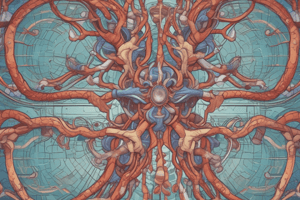Podcast
Questions and Answers
What type of receptors does epinephrine interact with?
What type of receptors does epinephrine interact with?
- Only beta receptors
- Both alpha and beta receptors (correct)
- Only alpha receptors
- Neither alpha nor beta receptors
What is the primary therapeutic use of norepinephrine?
What is the primary therapeutic use of norepinephrine?
- Treating acute hypotension in unstable patients (correct)
- Treating bronchospasm
- Relieving glaucoma symptoms
- Managing anaphylactic shock
What is the effect of dopamine on renal blood flow?
What is the effect of dopamine on renal blood flow?
- Initially increases then decreases renal blood flow
- Has no effect on renal blood flow
- Increases renal blood flow (correct)
- Decreases renal blood flow
Which of the following is a side effect of epinephrine?
Which of the following is a side effect of epinephrine?
What is the difference in the effects of low-dose and high-dose epinephrine?
What is the difference in the effects of low-dose and high-dose epinephrine?
What is the therapeutic use of isoproterenol?
What is the therapeutic use of isoproterenol?
What is the primary action of dopamine on the cardiovascular system?
What is the primary action of dopamine on the cardiovascular system?
What is the therapeutic use of fenoldopam?
What is the therapeutic use of fenoldopam?
What is the difference between dopamine 1 and dopamine 2 receptors?
What is the difference between dopamine 1 and dopamine 2 receptors?
What is the therapeutic use of dobutamine?
What is the therapeutic use of dobutamine?
What is the mechanism of action of cocaine?
What is the mechanism of action of cocaine?
What is the effect of phenoxybenzamine on blood pressure?
What is the effect of phenoxybenzamine on blood pressure?
What is the effect of β blockers on cardiac output?
What is the effect of β blockers on cardiac output?
What is the mechanism of action of quinazoline-based drugs?
What is the mechanism of action of quinazoline-based drugs?
What is the mechanism of β blockers in reducing renin secretion?
What is the mechanism of β blockers in reducing renin secretion?
What is the primary use of prazosin?
What is the primary use of prazosin?
What is the effect of phentolamine on the pupil?
What is the effect of phentolamine on the pupil?
Which of the following β blockers is a hybrid antihypertensive drug?
Which of the following β blockers is a hybrid antihypertensive drug?
What is the mechanism of action of reserpine?
What is the mechanism of action of reserpine?
What is the effect of β blockers with ISA on the heart rate?
What is the effect of β blockers with ISA on the heart rate?
What is the effect of guanethidine on blood pressure?
What is the effect of guanethidine on blood pressure?
What is the clinical use of β blockers in relation to myocardial infarction?
What is the clinical use of β blockers in relation to myocardial infarction?
Which of the following β blockers is cardio-selective?
Which of the following β blockers is cardio-selective?
What is the primary adverse effect of guanethidine?
What is the primary adverse effect of guanethidine?
What is the effect of tamsulosin on urinary flow?
What is the effect of tamsulosin on urinary flow?
What is the effect of β blockers on automaticity of the sinoatrial (SA) node?
What is the effect of β blockers on automaticity of the sinoatrial (SA) node?
Which generation of β blockers includes non-selective β blockers?
Which generation of β blockers includes non-selective β blockers?
What is the first dose phenomenon associated with quinazoline-based drugs?
What is the first dose phenomenon associated with quinazoline-based drugs?
Flashcards are hidden until you start studying
Study Notes
Adrenergic Agonists
- Act on receptors stimulated by epinephrine and norepinephrine
- Mediate major effects through β receptors
- β1: Increase myocardial contractility, heart rate, and lipolysis
- β2: Vasodilation, bronchodilation, relaxation of uterine smooth muscle
- β3: Lipolysis in adipose tissue
Direct Acting Adrenergic Agonists
- Endogenous/Natural Occurring: Epinephrine, Norepinephrine, Dopamine
- Synthetic: Dobutamine, Isoproterenol
- Epinephrine: interacts with alpha and beta receptors, depending on dose
- Low dose: beta receptor activity predominates (vasodilation)
- High dose: alpha receptor activity predominates (vasoconstriction)
Actions of Epinephrine
- Cardiovascular system: (+) inotropic and chronotropic effects, peripheral vasoconstriction and vasodilation
- Respiratory system: Bronchodilation
- Liver: Glycogenolysis
- Pancreas: Insulin secretion
- Adipose tissue: Lipolysis
Therapeutic Use of Epinephrine
- Bronchospasm
- Anaphylactic shock
- Glaucoma
- Anesthetics
Norepinephrine
- Affects mostly alpha receptors
- Actions:
- Cardiovascular: vasoconstriction
- Therapeutic use:
- Acute hypotension
- Atropine pre-treatment
- Cardiac arrest
Isoproterenol
- Non-selective β1 and β2 agonist
- Actions:
- Cardiovascular: (+) inotropic and chronotropic effects, decreased peripheral resistance
- Pulmonary: Bronchodilation
- Therapeutic use: Bronchial Asthma
Dopamine
- Acts on A1 and B1 receptors
- D1 receptors: vasodilation, especially in renal, coronary, mesenteric, and cerebral vascular beds
- D2 receptors: inhibit norepinephrine release
- Actions:
- Cardiovascular: (+) inotropic and chronotropic effects, vasoconstriction, and vasodilation
- Therapeutic use: Primarily used for cardiogenic shock and acute heart failure
Other Direct Acting Agents
- Fenoldopam: IV, D1, and A2 receptors, rapid vasodilation for severe hypertension
- Phenylephrine: A1, nasal decongestant
- Dobutamine: B1, (+) inotropic effect, congestive heart failure
- Clonidine: A2, essential hypertension, CNS action
Indirect Acting Adrenergic Agents
- Amphetamines: release norepinephrine from presynaptic terminals, central stimulation
- Tyramine: increases norepinephrine release from presynaptic terminals
- Cocaine: local anesthetic, blocks Na+/K+ pump, enhances norepinephrine activity
- Mixed-Action Adrenergic Agents:
- Ephedrine: enhances contractility, Myasthenia Gravis
- Metaraminol: shock treatment, alternative to norepinephrine
Adrenergic Agonists Side Effects
- Arrhythmias
- Headache
- Hyperactivity
- Insomnia
- Nausea
- Tremors
Studying That Suits You
Use AI to generate personalized quizzes and flashcards to suit your learning preferences.




